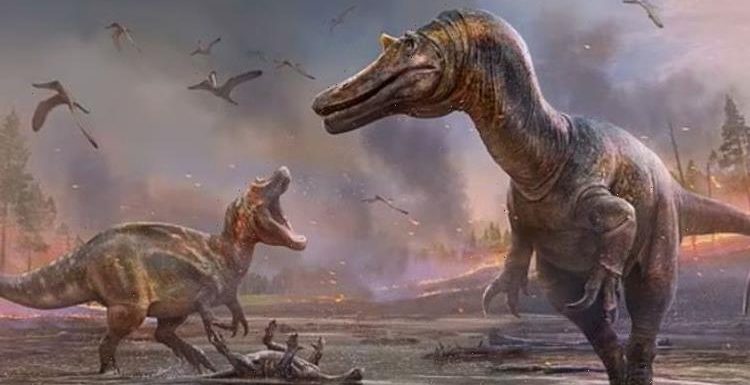
Megalosaurus: Ellie Harrison discusses English dinosaur
We use your sign-up to provide content in ways you’ve consented to and to improve our understanding of you. This may include adverts from us and 3rd parties based on our understanding. You can unsubscribe at any time. More info
Scientists say the remains were laid down over 125 million years ago during the Early Cretaceous period. They were found on a beach near Brighstone, Isle of Wight, over last few years by fossil collectors and academics. The bones are suspected to come from dinosaurs closely related to the giant Spinosaurus, which are known for having had strange crocodile-like skulls that allowed them to hunt prey on land as well as in water.
Before this recent discovery, the only spinosaurid skeleton found in the UK belonged to the dinosaur Baryonyx.
It was found in a quarry in Surrey in 1983.
The other finds relating to this dinosaur have been limited to isolated teeth and single bones.
Researchers from the University of Southampton have analysed the new fossils and confirmed that they belong to previously unknown species of dinosaurs.


Before this recent discovery, the only spinosaurid skeleton found in the UK belonged to the dinosaur Baryonyx.
It was found in a quarry in Surrey in 1983.
The other finds relating to this dinosaur have been limited to isolated teeth and single bones.
Researchers from the University of Southampton have analysed the new fossils and confirmed that they belong to previously unknown species of dinosaurs.
Chris Barker, lead author of the study, said: “We found the skulls to differ not only from Baryonyx, but also one another, suggesting the UK housed a greater diversity of spinosaurids than previously thought.”
READ MORE:

Co-author Darren Naish said he had been hoping for a Baronyx-like discovery on the Isle of Wight to pop up for at least two decades, but that finding two at once was a “huge surprise”.
One of the newly found dinosaurs has been given the name Ceratosuchops inferodios.
Translated from Latin, it means “horned crocodile-faced hell heron”.
It has a series of low horns and bumps shaped along its brow.
“Hell heron” refers to its suspected hunting style, as herons catch aquatic prey around the edges of waterways but can also eat prey found on land.
The second dinosaur was given the name Riparovenator mineral.
This translates to “Milner’s riverbank hunter”, paying tribute to the British palaeontologist Angela Milner who passed away this August and had named the Baryonyx dinosaur.
DON’T MISS
Britons face £2,500 bill to replace unsuitable heating pipes [INSIGHT]
Archaeologists find Hitler’s 3,300mph ‘superweapon’ buried in Kent [REVEAL]
China ready to ‘bridge differences’ with EU [REPORT]


It was around 29 feet long and was a carnivorous reptile about the same length as a stegosaurus.
Dr David Hone, another co-author, said: “It might sound odd to have two similar and closely related carnivores in an ecosystem, but this is actually very common for both dinosaurs and numerous living ecosystems.”
Dr Neil Gostling of the University of Southampton, who supervised the project, said: “This work has brought together universities, Dinosaur Isle museum and the public to reveal these amazing dinosaurs and the incredibly diverse ecology of the south coast of England 125 million years ago.”
Fossil collector Brian Foster, who made an important contribution to the finds, said it was “the rarest and most exciting find I’ve made in over 30 years of fossil collecting”.
The study was published in the journal Scientific Reports.
Source: Read Full Article